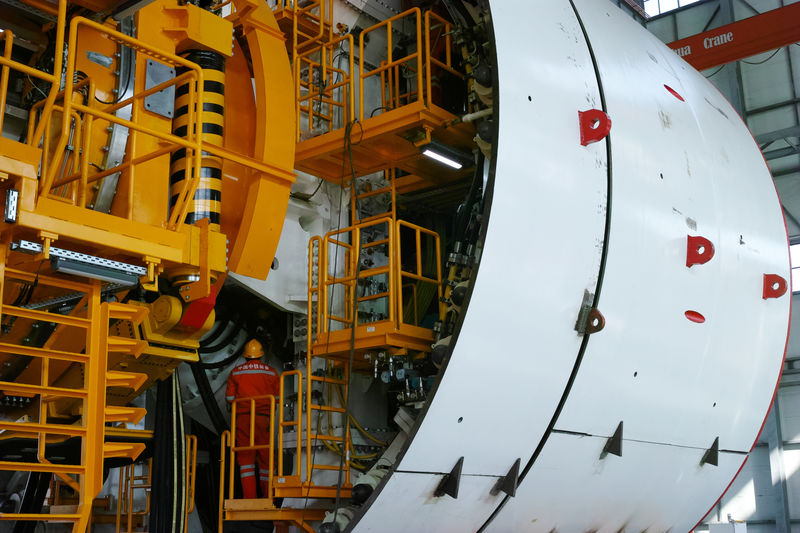By Gabriel Crossley and Ryan Woo
BEIJING (Reuters) - Factory activity in China shrank for the sixth straight month in October and by more than expected, while service sector growth eased as firms grapple with the weakest economic growth in nearly 30 years.
The world's second-largest economy is facing heightened risks from slowing global demand and the Sino-U.S. trade war, adding pressure on policymakers to roll out more stimulus to avoid a sharper slowdown and bigger job losses.
The Purchasing Managers' Index (PMI) fell to 49.3 in October, China's National Bureau of Statistics said on Thursday, versus 49.8 in September. The 50-point mark separates growth from contraction on a monthly basis.
Economists polled by Reuters had expected the reading would be unchanged from September.
Weighed down by cooling domestic demand, sluggish investment and a protracted trade war with the United States, China's economic growth slowed to a near 30-year low of 6.0% in the third quarter, raising expectations that Beijing will need to roll out more support measures soon.
New export orders fell for the 17th month in a row in October, with the sub-index down to 47.0 from 48.2 in the previous month.
Total new orders, which includes those for export and domestic use, fell back to contractionary territory and erased September's fleeting growth, suggesting continued weakness in demand at home.
Demand contraction would put a dent on prices and further chip away the already-thin margin for manufacturers. In September, China's producer prices posted the steepest decline in more than three years, while industrial profits shrank for the second month.
Factories continued to shed jobs in October on weakening demand and rising business uncertainties. The sub-index for employment was at 47.3 in October compared with 47.0 the previous month.
China's manufacturing sector will remain under pressure in the coming months as the nearly 16-months long Sino-U.S. trade war remains unresolved although Washington and Beijing are working on a first-phase trade accord that could be finalised soon.
But even if a "phase one" trade deal were signed it would be unlikely to have a significant positive impact on industrial activity, said Raymond Yeung, ANZ's chief Greater China economist in Hong Kong. Slumping price indexes in both the manufacturing and services PMIs point to increasing deflationary risk amid a pointed slowdown in economic momentum, he said.
Activity at larger firms slipped back into contractionary territory after a slight recovery in September. Gauges of activity at small- and medium-sized firms continued to be even lower.
"The official PMIs fell by more than expected this month, reinforcing our view that the improvement at the end of Q3 didn't mark the start of a sustained recovery," said Julian Evans-Pritchard, senior China economist at Capital Economics.
He said in a research note the construction index picked up, suggesting that building activity remained a bright spot, but adding this was overshadowed by a large drop in the index for service sector activity.
Growth in China's services sector activity slowed in October, flagging a further weakening in domestic demand.
The official services PMI fell to 52.8 from 53.7 in September, the lowest it has been since February 2016 but still above the 50-mark that separates contraction from expansion, according to a separate NBS survey.
Beijing has been counting on robust services firms to partly offset sluggish domestic and global demand for its manufactured products.
The services sector, which makes up more than 50% of the economy, has been propped up by Chinese consumers' rising wages and robust spending power in recent years. However, the services sector cooled late last year amid a broader economic downturn.
"We expect the official manufacturing PMI to remain sluggish in coming months, the growth slowdown could gather pace, and markets could become more volatile in coming months," said analysts from Nomura in a note, adding that Beijing will likely ramp up stimulus measures in the coming quarters.
GROWTH FEARS
The ruling Communist Party's People's Daily said stabilising growth should be made more of a priority. The commentary published on Thursday called for expanding investment in infrastructure where it is needed.
A Reuters poll showed China's gross domestic product growth is expected to slow to 6.2% in 2019 and then hit 5.9% in 2020.
"Current economic conditions are very similar to 2009," said ANZ's Yeung, but he thinks Beijing will not launch a major stimulus as it did then.
While there is room for lower rates, Yeung said Beijing is more likely to rely on industrial policy and fiscal support measures to keep the slowdown gradual and ensure a so-called "soft landing" for the economy.
China's southern province of Guangdong plans to use some of its 2020 bond issuance quota to issue debt as early as November, three sources with knowledge of the situation told Reuters.
Local government bond issuance typically begins in March but the statistics bureau has said the country would front-load some 2020 special local government bond issuance to this year.
